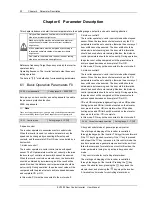
34 Chapter 6 Parameter Description
EV3200 Door Control Inverter User Manual
F7.01 Speed regulator's
integral time 1
Setting range: 0, 0.032 ~ 32.00s
【
1.000
】
F7.02 Speed regulator's
proportional gain 2
Setting range: 0.000 ~ 6.000
【
0.600
】
F7.03 Speed regulator's
integral time 2
Setting range: 0, 0.032 ~ 32.00s
【
1.000
】
F7.04 Speed regulator's
changing frequency
Setting range: 0.00 ~ 50.00Hz
【
5.00
】
Speed regulator's proportional gain P and integral time I can
be set by F7.00 ~ F7.04 to change the speed response of
vector control.
1. Structure of speed regulator (ASR) is shown in Figure
6-15, where K
p
is proportional gain P, and K
I
is integral time
I.
Frequency
instruction
Actual speed
Reference
torque current
+
Speed
error
Torque limit
(F7.06, F7.07)
K
p
(1+ )
1
K
I
S
-
Figure 6-15 Simplified speed regulator diagram
If the integral time is set at 0 (F7.01=0, F7.03=0), which
means integral function is disabled, and the speed loop is
simply a proportion regulator.
2. Adjustment of proportional gain P and integral time I for
speed regulator.
Instructed
speed
Bigger proportional gain
Shorter integral time
Small proportional gain
Instructed
speed
Longer integral time
Figure 6-16 Speed regulator's step response vs. P and I
Increasing P will fasten system transient response, but
system oscillation may occur given too big P.
Decreasing I will fasten transient response, but system
oscillation and overshoot may occur given too small.
Normally, you may tune P first, increase its value as long as
no system oscillation occurs; then adjust I, ensuring fast
response without overshoot. Figure 6-17 shows better
speed step response if P, I are set properly.
Instructed speed
Figure 6-17 Step response with better dynamic performance
3. Speed regulator's P, I Settings in High/Low Speed
Applications
If the system is required to respond quickly both in low and
high frequency operation with load and, then the user may
set speed regulator's switching frequency in F7.04. Normally,
when the system runs at low frequency, the transient
response performance can be improved by increasing P
and decreasing I.
Adjust speed regulator's parameters following the
procedures below:
Set appropriate switching frequency F7.04.
First tune P (F7.00) and I (F7.01) for high-speed application,
ensuring no oscillation and short response time.
Next, tune P (F7.02) and I (F7.03) for low-speed application,
ensure no oscillation and good response performance at
low frequency.
F7.05 Slip compensation
gain
Setting range: 0, 50.0% ~
250.0%
【
100.0%
】
F7.05 is used in calculating slip frequency. The setting
100% means rated slip frequency corresponds to rated
torque current. The user may decrease/increase the
settings of F7.05 to adjust the speed control's difference
accurately.
F7.06 Motoring
torque limit
Setting range: 0.0% ~ 200.0%
【
100.0%
】
F7.07 Braking
torque limit
Setting range: 0.0% ~ 200.0%
【
100.0%
】
Torque limiting is used to limit the speed regulator's output
torque current.
Torque limit is the percentage of the inverter's rated current;
if the torque limit is 100%, then the torque current limit is the
inverter's rated current. F7.06 and F7.075 limit the output
torque in motorizing state and braking state respectively, as
shown in Figure 6-18.
Motor running speed
FWD running
REV runing
Braking
status
Braking
status
Output torque
F7.07
F7.07
F7.06
F7.06
Motorizing
status
Positive torque
Negative torque
Motorizing
status
Figure 6-18 Torque limiting function
F7.08 Current loop’s
proportional gain KP
Setting range: 0 ~ 9999
【
500
】
F7.09 Current loop’s
integral time KI
Setting range: 0 ~ 9999
【
300
】
F7.08 and F7.09 are PI regulator parameters of current loop.
Increasing current loop KP or KI can fasten system transient
response to output torque; reducing KP or KI can increase
system stability.
Too big current loop KP or KI increases the possibility of
system oscillation; too small KP or KI may affect the system
torque output capability.






























